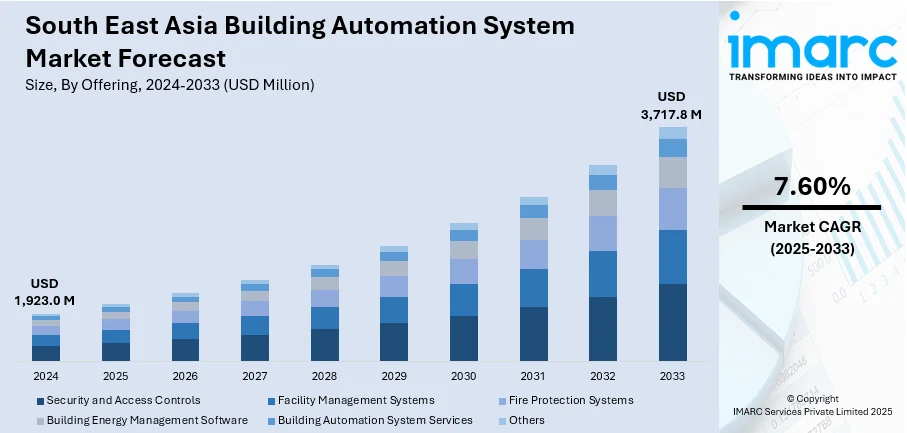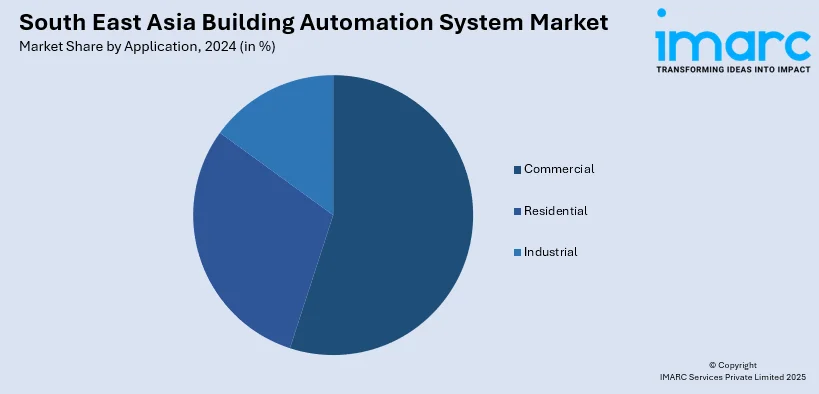
South East Asia Building Automation System Market Size, Share, Trends and Forecast by Offering, Communication Technology, Application, and Country, 2025-2033
Market Overview:
South East Asia building automation system market size reached USD 1,923.0 Million in 2024. Looking forward, IMARC Group expects the market to reach USD 3,717.8 Million by 2033, exhibiting a growth rate (CAGR) of 7.60% during 2025-2033. The continuous advancements in sensor technologies, connectivity, and data analytics, which contribute to the development of more sophisticated and efficient building automation system solutions, attracting businesses and organizations to upgrade their systems, are driving the market.
|
Report Attribute
|
Key Statistics
|
|---|---|
|
Base Year
|
2024
|
|
Forecast Years
|
2025-2033
|
|
Historical Years
|
2019-2024
|
|
Market Size in 2024
|
USD 1,923.0 Million |
|
Market Forecast in 2033
|
USD 3,717.8 Million |
| Market Growth Rate 2025-2033 | 7.60% |
A building automation system (BAS) is a centralized control system that manages and monitors a variety of building functions, ensuring efficient and sustainable operation. It integrates diverse systems such as HVAC, lighting, security, and more, enabling automated control and optimization of building performance. BAS enhances energy efficiency, reduces operational costs, and improves occupant comfort by adjusting settings based on real-time data and predefined parameters. Sensors and actuators collect information and execute commands, allowing for dynamic responses to changing conditions. Additionally, remote access and data analytics enable facility managers to make informed decisions for ongoing optimization. The implementation of a BAS contributes to sustainability goals, enhances building resilience, and streamlines maintenance processes, making it a fundamental component in modern smart buildings.

To get more information on this market, Request Sample
South East Asia Building Automation System Market Trends:
The building automation system market in South East Asia is experiencing robust growth, driven by several key factors. Firstly, the escalating demand for energy-efficient solutions has propelled the adoption of BAS across residential, commercial, and industrial sectors. Additionally, the imperative for cost reduction and operational efficiency has incentivized organizations to invest in sophisticated automation systems. Furthermore, the rising emphasis on sustainable and green building practices has elevated the significance of BAS in achieving environmental objectives. Moreover, the proliferation of smart technologies and the Internet of Things (IoT) has significantly augmented the capabilities of BAS, allowing for seamless integration and real-time monitoring. The convergence of data analytics and artificial intelligence within BAS enhances predictive maintenance, optimizing building performance and reducing downtime. Additionally, the increasing awareness of occupant comfort and well-being has prompted a surge in demand for smart building solutions, where BAS plays a pivotal role in managing lighting, temperature, and ventilation systems. Furthermore, stringent government regulations and initiatives promoting energy conservation have become pivotal drivers for the BAS market. As organizations strive to comply with these regulations, the implementation of advanced automation systems becomes imperative, fostering the growth of the BAS market. In essence, the confluence of environmental consciousness, technological advancements, and regulatory pressures collectively propels the trajectory of the regional market.
South East Asia Building Automation System Market Segmentation:
IMARC Group provides an analysis of the key trends in each segment of the market, along with forecasts at the regional and country levels for 2025-2033. Our report has categorized the market based on offering, communication technology, and application.
Offering Insights:
- Security and Access Controls
- Facility Management Systems
- Fire Protection Systems
- Building Energy Management Software
- Building Automation System Services
- Others
The report has provided a detailed breakup and analysis of the market based on the offering. This includes security and access controls, facility management systems, fire protection systems, building energy management software, building automation system services, and others.
Communication Technology Insights:
- Wireless
- Wired
A detailed breakup and analysis of the market based on the communication technology have also been provided in the report. This includes wireless and wired.
Application Insights:

- Commercial
- Residential
- Industrial
The report has provided a detailed breakup and analysis of the market based on the application. This includes commercial, residential, and industrial.
Country Insights:
- Indonesia
- Thailand
- Singapore
- Philippines
- Vietnam
- Malaysia
- Others
The report has also provided a comprehensive analysis of all the major regional markets, which include Indonesia, Thailand, Singapore, Philippines, Vietnam, Malaysia, and Others.
Competitive Landscape:
The market research report has also provided a comprehensive analysis of the competitive landscape in the market. Competitive analysis such as market structure, key player positioning, top winning strategies, competitive dashboard, and company evaluation quadrant has been covered in the report. Also, detailed profiles of all major companies have been provided.
South East Asia Building Automation System Market Report Coverage:
| Report Features | Details |
|---|---|
| Base Year of the Analysis | 2024 |
| Historical Period | 2019-2024 |
| Forecast Period | 2025-2033 |
| Units | Million USD |
| Scope of the Report | Exploration of Historical Trends and Market Outlook, Industry Catalysts and Challenges, Segment-Wise Historical and Future Market Assessment:
|
| Offerings Covered | Security and Access Controls, Facility Management Systems, Fire Protection Systems, Building Energy Management Software, Building Automation System Services, Others |
| Communication Technologies Covered | Wireless, Wired |
| Applications Covered | Commercial, Residential, Industrial |
| Countries Covered | Indonesia, Thailand, Singapore, Philippines, Vietnam, Malaysia, Others |
| Customization Scope | 10% Free Customization |
| Post-Sale Analyst Support | 10-12 Weeks |
| Delivery Format | PDF and Excel through Email (We can also provide the editable version of the report in PPT/Word format on special request) |
Key Questions Answered in This Report:
- How has the South East Asia building automation system market performed so far and how will it perform in the coming years?
- What is the breakup of the South East Asia building automation system market on the basis of offering?
- What is the breakup of the South East Asia building automation system market on the basis of communication technology?
- What is the breakup of the South East Asia building automation system market on the basis of application?
- What are the various stages in the value chain of the South East Asia building automation system market?
- What are the key driving factors and challenges in the South East Asia building automation system?
- What is the structure of the South East Asia building automation system market and who are the key players?
- What is the degree of competition in the South East Asia building automation system market?
Key Benefits for Stakeholders:
- IMARC’s industry report offers a comprehensive quantitative analysis of various market segments, historical and current market trends, market forecasts, and dynamics of the South East Asia building automation system market from 2019-2033.
- The research report provides the latest information on the market drivers, challenges, and opportunities in the South East Asia building automation system market.
- Porter's five forces analysis assist stakeholders in assessing the impact of new entrants, competitive rivalry, supplier power, buyer power, and the threat of substitution. It helps stakeholders to analyze the level of competition within the South East Asia building automation system industry and its attractiveness.
- Competitive landscape allows stakeholders to understand their competitive environment and provides an insight into the current positions of key players in the market.
Need more help?
- Speak to our experienced analysts for insights on the current market scenarios.
- Include additional segments and countries to customize the report as per your requirement.
- Gain an unparalleled competitive advantage in your domain by understanding how to utilize the report and positively impacting your operations and revenue.
- For further assistance, please connect with our analysts.
 Request Customization
Request Customization
 Speak to an Analyst
Speak to an Analyst
 Request Brochure
Request Brochure
 Inquire Before Buying
Inquire Before Buying




.webp)




.webp)












